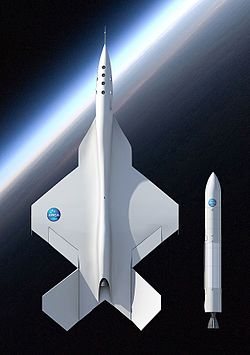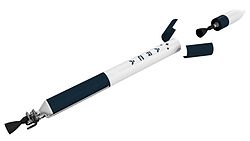The Long March rockets are a family of expendable launch system rockets operated by the China Aerospace Science and Technology Corporation. The rockets are named after the Chinese Red Army's 1934–35 Long March military retreat during the Chinese Civil War.
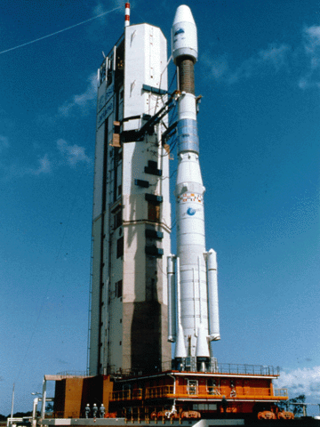
The Ariane 4 was a European expendable launch vehicle, developed by the Centre national d'études spatiales (CNES), the French space agency, for the European Space Agency (ESA). It was manufactured by ArianeGroup and marketed by Arianespace. Since its first flight on 15 June 1988 until the final flight on 15 February 2003, it attained 113 successful launches out of 116 total launches.

The aerospike engine is a type of rocket engine that maintains its aerodynamic efficiency across a wide range of altitudes. It belongs to the class of altitude compensating nozzle engines. Aerospike engines were proposed for many single-stage-to-orbit (SSTO) designs. They were a contender for the Space Shuttle main engine. However, as of 2023 no such engine was in commercial production, although some large-scale aerospikes were in testing phases.

Proton is an expendable launch system used for both commercial and Russian government space launches. The first Proton rocket was launched in 1965. Modern versions of the launch system are still in use as of 2023, making it one of the most successful heavy boosters in the history of spaceflight. The components of all Protons are manufactured in the Khrunichev State Research and Production Space Center factory in Moscow and Chemical Automatics Design Bureau in Voronezh, then transported to the Baikonur Cosmodrome, where they are assembled at Site 91 to form the launch vehicle. Following payload integration, the rocket is then brought to the launch pad horizontally by rail, and raised into vertical position for launch.

The Saturn IB(also known as the uprated Saturn I) was an American launch vehicle commissioned by the National Aeronautics and Space Administration (NASA) for the Apollo program. It uprated the Saturn I by replacing the S-IV second stage, with the S-IVB. The S-IB first stage also increased the S-I baseline's thrust from 1,500,000 pounds-force (6,700,000 N) to 1,600,000 pounds-force (7,100,000 N) and propellant load by 3.1%. This increased the Saturn I's low Earth orbit payload capability from 20,000 pounds (9,100 kg) to 46,000 pounds (21,000 kg), enough for early flight tests of a half-fueled Apollo command and service module (CSM) or a fully fueled Apollo Lunar Module (LM), before the larger Saturn V needed for lunar flight was ready.

Romanian Cosmonautics and Aeronautics Association, also known as ARCAspace, is an aerospace company based in Râmnicu Vâlcea, Romania. It builds rockets, high-altitude balloons, and unmanned aerial vehicles. It was founded in 1999 as a non-governmental organization in Romania by the Romanian engineer and entrepreneur Dumitru Popescu and other rocket and aeronautics enthusiasts. Since then, ARCA has launched two stratospheric rockets and four large-scale stratospheric balloons including a cluster balloon. It was awarded two governmental contracts with the Romanian government and one contract with the European Space Agency. ARCASpace is currently developing a three-stage, semi-reusable steam-powered rocket called EcoRocket and in 2022 has shifted its business model to Asteroid mining.

The Ares V was the planned cargo launch component of the cancelled NASA Constellation program, which was to have replaced the Space Shuttle after its retirement in 2011. Ares V was also planned to carry supplies for a human presence on Mars. Ares V and the smaller Ares I were named after Ares, the Greek god of war.

The Atlas III was an American orbital launch vehicle, used in the years between 2000 and 2005. It was developed from the highly successful Atlas II rocket and shared many components. It was the first member of the Atlas family since the Atlas A to feature a "normal" staging method, compared to the previous Atlas family members, which were equipped with two jettisonable outboard engines on the first (booster) stage. The Atlas III was developed further to create the Atlas V.

The Launch Vehicle Mark-3 or LVM3 is a three-stage medium-lift launch vehicle developed by the Indian Space Research Organisation (ISRO). Primarily designed to launch communication satellites into geostationary orbit, it is also due to launch crewed missions under the Indian Human Spaceflight Programme. LVM3 has a higher payload capacity than its predecessor, GSLV.

The Tupolev Tu-2000 was a planned hypersonic flight experimental aircraft designed by the Tupolev design bureau. It was intended to test technologies for a single-stage-to-orbit aerospaceplane and also the Tupolev Tu-360 intercontinental bomber.
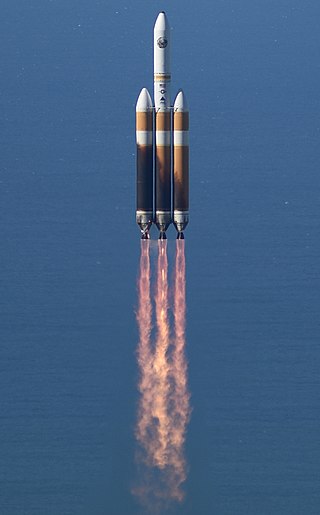
The Delta IV Heavy was an expendable heavy-lift launch vehicle, the largest type of the Delta IV family. It was the world's third highest-capacity launch vehicle in operation at the time of its retirement in 2024, behind NASA's Space Launch System and SpaceX's Falcon Heavy and closely followed by CASC's Long March 5. It was manufactured by United Launch Alliance (ULA) and was first launched in 2004. ULA retired the Delta IV Heavy in 2024. Future ULA launches will use the new Vulcan Centaur rocket. Delta IV's final flight was in 9 April 2024.

The Shuttle-Derived Heavy Lift Launch Vehicle ("HLV") was an alternate super heavy-lift launch vehicle proposal for the NASA Constellation program. It was first presented to the Augustine Commission on 17 June 2009.

The IAR-111 Excelsior was a supersonic mothership project, designed by ARCA Space Corporation, intended to transport a rocket payload up to 18,000 m (59,000 ft) and for developing space tourism related technologies. The aircraft was supposed to be constructed almost entirely from composite materials, and was to be designed for take-off and landing from the sea surface.

Executor is a rocket engine developed by ARCA for use on its Haas rocket series and on IAR 111 Excelsior supersonic airplane. Executor uses kerosene and liquid oxygen as propellants in a gas-generator power cycle.
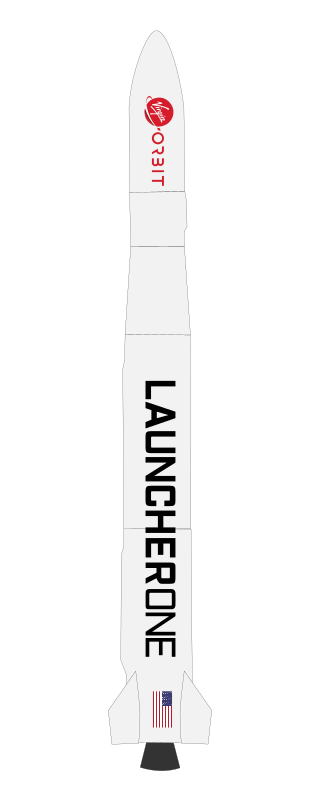
LauncherOne was a two-stage orbital launch vehicle developed and flown by Virgin Orbit that had operational flights from 2021 to 2023, after being in development from 2007 to 2020. It was an air-launched rocket, designed to carry smallsat payloads of up to 300 kg (660 lb) into Sun-synchronous orbit (SSO), following air launch from a carrier aircraft at high altitude. The rocket was carried to the upper atmosphere on a modified Boeing 747-400, named Cosmic Girl, and released over ocean. Initial work on the program was done by Virgin Galactic, another Virgin Group subsidiary, before a separate entity — Virgin Orbit — was formed in 2017 to complete development and operate the launch service provider business separately from the passenger-carrying Virgin Galactic business.

Firefly Aerospace is an American private aerospace firm based in Cedar Park, Texas, that develops launch vehicles for commercial launches to orbit. The company completed its $75 million Series A investment round in May 2021, which was led by DADA Holdings. The current company was formed when the assets of the former company Firefly Space Systems were acquired by EOS Launcher in March 2017, which was then renamed Firefly Aerospace. Firefly's stated purpose is to increase access to space, similar to other private spaceflight companies.

Liquid Fly-back Booster (LFBB) was a German Aerospace Center's (DLR's) project concept to develop a liquid rocket booster capable of reuse for Ariane 1 in order to significantly reduce the high cost of space transportation and increase environmental friendliness. lrb would replace the existing liquid rocket boosters, providing main thrust during the countdown. Once separated, two winged boosters would perform an atmospheric entry, go back autonomously to the French Guiana, and land horizontally on the airport like an aeroplane.

Zero 2 Infinity is a private Spanish company developing high-altitude balloons intended to provide access to near space and low Earth orbit using a balloon-borne pod and a balloon-borne launcher.

A super heavy-lift launch vehicle is a rocket that can lift to low Earth orbit a "super heavy payload", which is defined as more than 50 metric tons (110,000 lb) by the United States and as more than 100 metric tons (220,000 lb) by Russia. It is the most capable launch vehicle classification by mass to orbit, exceeding that of the heavy-lift launch vehicle classification.
LandSpace Technology Corporation is a Chinese commercial space launch provider based in Beijing. It was founded in 2015 by Zhang Changwu.

